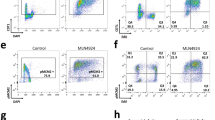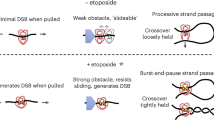Abstract
DNaseY, a Ca2+- and Mg2+-dependent endonuclease, has been implicated in apoptotic DNA degradation; however, the molecular mechanisms controlling its involvement in this process have not been fully elucidated. We have obtained evidence from yeast two-hybrid screening and coimmunoprecipitation experiments that DNaseY interacted physically with actinin-α4 and this interaction significantly enhanced its endonuclease activity. Accordingly, simultaneous overexpression of both proteins in PC12 cells dramatically increased the rate of apoptosis in response to teniposide' VM26. However, overexpression of DNaseY alone neither triggered apoptosis nor facilitated cell death in response to VM26 or serum deprivation. Instead, the overexpression of DNaseY increased the production of single-strand DNA breaks and evoked a profound upregulation of DNA repair pathways. Taken together, our results point to a novel regulatory mechanism of DNaseY activity and offer an explanation for why cells must first cleave key DNA repair and replication proteins before the successful execution of apoptosis.
Similar content being viewed by others
Log in or create a free account to read this content
Gain free access to this article, as well as selected content from this journal and more on nature.com
or
Abbreviations
- MARs:
-
matrix attachment regions
- ssb:
-
single-strand break
- BUR:
-
base-unpairing region
- ds:
-
double strand
- ss:
-
single strand
- XRCC1:
-
X-ray repair cross complementing 1
- Polβ:
-
DNA polymerase β
- Lig3:
-
DNA ligase 3
- Polδ/ɛ:
-
DNA polymerase δ/ɛ
- PCNA:
-
proliferating cell nuclear antigen
- Lig1:
-
DNA ligase1
References
Lagarkova MA, Iarovaia OV and Razin SV (1995) Large-scale fragmentation of mammalian DNA in the course of apoptosis proceeds via excision of chromosomal DNA loops and their oligomers. J. Biol. Chem. 270: 20239–20241
Walker PR and Sikorska M (1997) New aspects of the mechanism of DNA fragmentation in apoptosis. Biochem. Cell Biol. 75: 287–299
Sakahira H, Enari M and Nagata S (1998) Cleavage of CAD inhibitor in CAD activation and DNA degradation during apoptosis. Nature 391: 96–99
Walisser JA and Thies RL (1999) Poly(ADP-ribose) polymerase inhibition in oxidant-stressed endothelial cells prevents oncosis and permits caspase activation and apoptosis. Exp. Cell Res. 251: 401–413
Boulares AH, Zoltoski AJ, Sherif ZA, Yakovlev AG and Smulson ME (2002) The Poly(ADP-ribose) polymerase-1-regulated endonuclease DNAS1L3 is required for etoposide-induced internucleosomal DNA fragmentation and increases etoposide cytotoxicity in transfected osteosarcoma cells. Cancer Res. 62: 4439–4444
Enari M, Sakahira H, Yokoyama H, Okawa K, Iwamatsu A and Nagata S (1998) A caspase-activated DNase that degrades DNA during apoptosis, and its inhibitor ICAD. Nature 391: 43–50
Baron WF, Pan CQ, Spencer SA, Ryan AM, Lazarus RA and Baker KP (1998) Cloning and characterization of an actin-resistant DNase I-like endonuclease secreted by macrophages. Gene 215: 291–301
Liu QY, Pandey S, Singh RK, Lin W, Ribecco M, Borowy-Borowski H, Smith B, LeBlanc J, Walker PR and Sikorska M (1998) DNaseY: a rat DNaseI-like gene coding for a constitutively expressed chromatin-bound endonuclease. Biochemistry 37: 10134–10143
Shiokawa D and Tanuma S (1998) Molecular cloning and expression of a cDNA encoding an apoptotic endonuclease DNase gamma. Biochem. J. 332: 713–720
Yakovlev AG, Wang G, Stoica BA, Simbulan-Rosenthal CM, Yoshihara K and Smulson ME (1999) Role of DNAS1L3 in Ca2+- and Mg2+-dependent cleavage of DNA into oligonucleosomal and high molecular mass fragments. Nucleic Acids Res. 27: 1999–2005
Li LY, Luo X and Wang X (2001) Endonuclease G is an apoptotic DNase when released from mitochondria. Nature 412: 95–99
Peitsch MC, Polzar B, Stephan H, Crompton T, MacDonald HR, Mannherz HG and Tschopp J (1993) Characterization of the endogenous deoxyribonuclease involved in nuclear DNA degradation during apoptosis (programmed cell death). EMBO J. 12: 371–377
Torriglia A, Perani P, Brossas JY, Chaudun E, Treton J, Courtois Y and Counis MF (1998) L-DNase II, a molecule that links proteases and endonucleases in apoptosis, derives from the ubiquitous serpin leukocyte elastase inhibitor. Mol. Cell. Biol. 18: 3612–3619
Kovacsovics M, Martinon F, Micheau O, Bodmer J, Hofmann K and Tschopp J (2002) Overexpression of helicard, a CARD-containing helicase cleaved during apoptosis, accelerates DNA degradation. Curr. Biol. 12: 1633
Chen J, Jin K, Chen M, Pei W, Kawaguchi K, Greenberg DA and Simon RP (1997) Early detection of DNA strand breaks in the brain after transient focal ischemia: implications for the role of DNA damage in apoptosis and neuronal cell death. J. Neurochem. 69: 232–245
Walker PR, LeBlanc J and Sikorska M (1997) Evidence that DNA fragmentation in apoptosis is initiated and propagated by single-strand breaks. Cell Death Differ. 4: 506–515
Liu QY, Ribecco-Lutkiewicz M, Carson C, Testolin L, Bergeron D, Kohwi-Shigematsu T, Walker PR and Sikorska M (2003) Mapping the initial DNA breaks in apoptotic Jurkat cells using ligation-mediated PCR. Cell Death Differ. 10: 278–289
Yakovlev AG, Wang G, Stoica BA, Boulares HA, Spoonde AY, Yoshihara K and Smulson ME (2000) A role of the Ca2+/Mg2+-dependent endonuclease in apoptosis and its inhibition by Poly(ADP-ribose) polymerase. J. Biol. Chem. 275: 21302–21308
Boulares AH, Zoltoski AJ, Contreras FJ, Yakovlev AG, Yoshihara K and Smulson ME (2002) Regulation of DNAS1L3 endonuclease activity by poly(ADP-ribosyl)ation during etoposide-induced apoptosis. Role of poly(ADP-ribose) polymerase-1 cleavage in endonuclease activation. J. Biol. Chem. 277: 372–378
de Murcia G and Menissier dM (1994) Poly(ADP-ribose) polymerase: a molecular nick-sensor. Trends Biochem. Sci. 19: 172–176
Jeggo PA (1998) DNA repair: PARP–another guardian angel? Curr. Biol. 8: R49–R51
Shall S and de Murcia G (2000) Poly(ADP-ribose) polymerase-1: what have we learned from the deficient mouse model? Mutat Res 460: 1–15
Masson M, Niedergang C, Schreiber V, Muller S, Menissier-de Murcia J and de Murcia G (1998) XRCC1 is specifically associated with poly(ADP-ribose) polymerase and negatively regulates its activity following DNA damage. Mol. Cell. Biol. 18: 3563–3571
Caldecott KW (2001) Mammalian DNA single-strand break repair: an X-ra(y)ted affair. Bioessays 23: 447–455
Honda K, Yamada T, Endo R, Ino Y, Gotoh M, Tsuda H, Yamada Y, Chiba H and Hirohashi S (1998) Actinin-4, a novel actin-bundling protein associated with cell motility and cancer invasion. J. Cell Biol. 140: 1383–1393
Pandey S, Walker PR and Sikorska M (1997) Identification of a novel 97?kDa endonuclease capable of internucleosomal DNA cleavage. Biochemistry 36: 711–720
Walker PR, LeBlanc J, Smith B, Pandey S and Sikorska M (1999) Detection of DNA fragmentation and endonucleases in apoptosis. Methods 17: 329–338
Takada F, Vander Woude DL, Tong HQ, Thompson TG, Watkins SC, Kunkel LM and Beggs AH (2001) Myozenin: an alpha-actinin- and gamma-filamin-binding protein of skeletal muscle Z lines. Proc. Natl. Acad. Sci. USA 98: 1595–1600
Nikolopoulos SN, Spengler BA, Kisselbach K, Evans AE, Biedler JL and Ross RA (2000) The human non-muscle alpha-actinin protein encoded by the ACTN4 gene suppresses tumorigenicity of human neuroblastoma cells. Oncogene 19: 380–386
Suhara T, Mano T, Oliveira BE and Walsh K (2001) Phosphatidylinositol 3-kinase/Akt signaling controls endothelial cell sensitivity to Fas-mediated apoptosis via regulation of FLICE-inhibitory protein (FLIP). Circ. Res. 89: 13–19
Bernstein C, Bernstein H, Payne CM and Garewal H (2002) DNA repair/pro-apoptotic dual-role proteins in five major DNA repair pathways: fail-safe protection against carcinogenesis. Mutat. Res. 511: 145–178
Trucco C, Oliver FJ, de Murcia G and Menissier-de Murcia J (1998) DNA repair defect in poly(ADP-ribose) polymerase-deficient cell lines. Nucleic Acids Res. 26: 2644–2649
Cote J and Ruiz-Carrillo A (1993) Primers for mitochondrial DNA replication generated by endonuclease G. Science 261: 765–769
Counis MF and Torriglia A (2000) DNases and apoptosis. Biochem. Cell Biol. 78: 405–414
Gavrieli Y, Sherman Y and Ben Sasson SA (1992) Identification of programmed cell death in situ via specific labeling of nuclear DNA fragmentation. J. Cell Biol. 119: 493–501
Acknowledgements
We thank Joanne Chartier and Min Wang for their technical assistance.
Author information
Authors and Affiliations
Corresponding author
Additional information
Edited by RA Lockshin
Rights and permissions
About this article
Cite this article
Liu, Q., Lei, J., LeBlanc, J. et al. Regulation of DNaseY activity by actinin-α4 during apoptosis. Cell Death Differ 11, 645–654 (2004). https://doi.org/10.1038/sj.cdd.4401401
Received:
Revised:
Accepted:
Published:
Issue date:
DOI: https://doi.org/10.1038/sj.cdd.4401401
Keywords
This article is cited by
-
Müller glial cells located in the peripheral retina are more susceptible to high pressure: implications for glaucoma
Cell & Bioscience (2024)
-
Dysregulated expression of ACTN4 contributes to endothelial cell injury via the activation of the p38-MAPK/p53 apoptosis pathway in preeclampsia
Journal of Physiology and Biochemistry (2019)
-
Serum level of DNase1l3 in patients with dermatomyositis/polymyositis, systemic lupus erythematosus and rheumatoid arthritis, and its association with disease activity
Clinical and Experimental Medicine (2017)
-
A novel neuron-enriched protein SDIM1 is down regulated in Alzheimer's brains and attenuates cell death induced by DNAJB4 over-expression in neuro-progenitor cells
Molecular Neurodegeneration (2011)
-
Actin complexes in the cell nucleus: new stones in an old field
Histochemistry and Cell Biology (2010)



